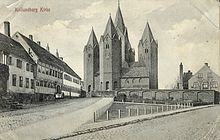
Saint Olaf, also called Saint Olav, Olaf the Holy, Olaf II, Olaf Haraldsson, and Olaf the Stout, was King of Norway from 1015 to 1028. Son of Harald Grenske, a petty king in Vestfold, Norway, he was posthumously given the title Rex Perpetuus Norvegiae and canonised at Nidaros (Trondheim) by Bishop Grimketel, one year after his death in the Battle of Stiklestad on 29 July 1030. His remains were enshrined in Nidaros Cathedral, built over his burial site. His sainthood encouraged the widespread adoption of Christianity by Scandinavia's Vikings/Norsemen.

Saint Lawrence or Laurence was one of the seven deacons of the city of Rome under Pope Sixtus II who were martyred in the persecution of the Christians that the Roman emperor Valerian ordered in 258.

Henry was a medieval English clergyman. He came to Sweden with Cardinal Nicholas Breakspeare in 1153 and was most likely designated to be the new Archbishop of Uppsala, but the independent church province of Sweden could only be established in 1164 after the civil war, and Henry would have been sent to organize the Church in Finland, where Christians had already existed for two centuries.

The Catholic Church in Sweden is part of the worldwide Catholic Church in communion with the Pope in Rome. It was established by Archbishop Ansgar in Birka in 829, and further developed by the Christianization of Sweden in the 9th century. King Olof Skötkonung is considered the first Christian king of Sweden.

Lund Cathedral is a cathedral of the Lutheran Church of Sweden in Lund, Scania, Sweden. It is the seat of the Bishop of Lund and the main church of the Diocese of Lund. It was built as the Catholic cathedral of the archiepiscopal see of all the Nordic countries, dedicated to Saint Lawrence. It is one of the oldest stone buildings still in use in Sweden.

Uppsala Cathedral is a cathedral located between the University Hall of Uppsala University and the Fyris river in the centre of Uppsala, Sweden. A church of the Church of Sweden, the national church, in the Lutheran tradition, Uppsala Cathedral is the seat of the Archbishop of Uppsala, the primate of Sweden. It is also the burial site of King Eric IX, who became the patron saint of the nation, and it was the traditional location for the coronation of new Kings of Sweden.

Saint Erik, also called Erik Jedvardsson, Eric IX, Eric the Holy, Saint Eric, and Eric the Lawgiver, was King of Sweden from c. 1156 until his death in 1160. The Roman Martyrology of the Catholic Church names him as a saint memorialized on 18 May. He was the founder of the House of Erik, which ruled Sweden with interruptions from c. 1156 to 1250.
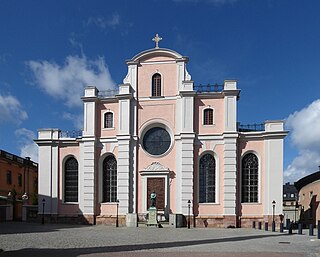
Storkyrkan, also called Stockholms domkyrka and Sankt Nikolai kyrka, is the oldest church in Stockholm. Storkyrkan lies in the centre of Stockholm in Gamla stan, between Stockholm Palace and Stortorget, the old main square of Stockholm. It was consecrated to Saint Nicholas in 1306 but construction of the church probably started in the 13th century. Inside, Storkyrkan still maintains much of its late medieval appearance in the form of a hall church with a vaulted ceiling supported by brick pillars. The exterior of the church is however uniformly Baroque in appearance, the result of extensive changes made in the 18th century. The church played an important role during the Reformation in Sweden as the place where Mass was celebrated in Swedish for the first time. It currently serves as the seat of the Bishop of Stockholm within the Church of Sweden since the creation of the Diocese of Stockholm in 1942.
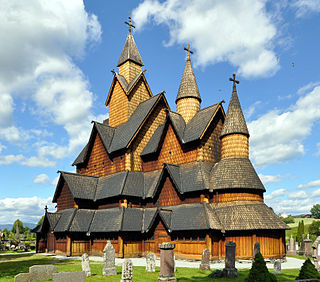
Heddal Stave Church is a parish church of the Church of Norway in Notodden Municipality in Telemark county, Norway. It is located in the village of Heddal. It is the church for the Heddal parish which is part of the Øvre Telemark prosti in the Diocese of Agder og Telemark. The wooden, triple nave stave church was built in a long church design around the year 1200 using plans drawn up by an unknown architect. The church seats about 180 people.
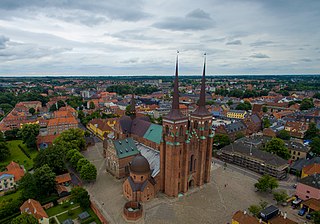
Roskilde Cathedral, in the city of Roskilde on the island of Zealand (Sjælland) in eastern Denmark, is a cathedral of the Lutheran Church of Denmark.

Dalby Church, sometimes also called the Church of the Holy Cross in Dalby is a church in Dalby, Lund Municipality in the Swedish province of Scania. It is one of the oldest churches in Sweden. When it was built Dalby was part of Denmark, and the church was commissioned by King Sweyn II of Denmark. It was constructed during the second half of the 11th century. For six years, it served as the seat of a bishop, before the diocese was merged with the Diocese of Lund nearby. The church was built with inspiration from Hildesheim Cathedral, and masons from Hildesheim appear to have worked on its construction site.

Växjö Cathedral is a cathedral in Växjö, Sweden. It is the seat of the Bishop of Växjö within the Church of Sweden. According to legend, the cathedral was founded by Saint Sigfrid of Sweden. The first stone church on the site, parts of which are incorporated into the current cathedral, was built in the 1160s. The cathedral has been much altered over time, and its appearance today is largely the result of a far-reaching restoration carried out in the 1950s under the guidance of architect Kurt von Schmalensee. Växjö Cathedral is a hall church with a western tower and a square choir. It was built on a location which was probably used as a marketplace during pre-Christian times. Very few of the cathedral's original furnishings have survived from earlier centuries; most of the works of art adorning the cathedral date from the 20th or 21st centuries, and many of them are made of glass.

Visby Cathedral, formally Visby Saint Mary's Cathedral, is a cathedral within the Church of Sweden, seat of the Bishop of Visby. It lies in the centre of Visby, the main town on the Swedish island Gotland. It was built as the church of the German traders in the city during the 13th century. The first church was probably a wooden church, which was later replaced by a stone building. Originally built as a basilica, it was successively expanded and rebuilt during the Middle Ages. At the end of this period it had been transformed to a hall church, which it still is. In 1361, Gotland and the church became part of Denmark. Following the Reformation, it was the only medieval church in the city left in use, and in 1572 raised to the status of cathedral. Since 1645 Gotland and the cathedral have been part of Sweden. A major renovation was carried out in 1899–1903 under the guidance of architect Axel Haig.

The Union Master, also Master of Undløse, is the name given to an anonymous artist active in the first half of the 15th century in Denmark and possibly Sweden, which were both part of the Kalmar Union, hence the name. It has been suggested that the Union Master is identical with the Master of Fogdö. He and his workshop decorated churches with frescoes of unusually high artistic quality.

Majestatis was a Romanesque stone sculptor and the creator of several richly decorated baptismal fonts mainly in Scania and on Gotland.

Othelric was a Romanesque stone sculptor, working in Västergötland, present-day Sweden.

Lärbro Church is a medieval church in Lärbro on the Swedish island of Gotland. The church is located at a former strategically important spot, as testified by the adjacent fortified tower. The presently visible Gothic church replaced an earlier Romanesque church during the 13th and 14th century. The cemetery of the church contains several graves of victims from Nazi concentration camps who were taken to a field hospital in Lärbro during and after World War II.

Esbern Snare, also known as Esbern the Resolute, (1127–1204) was a høvding, or chieftain, royal chancellor and crusader. His family were members of the powerful Hvide clan. In 1192, during the Crusades and after the fall of Jerusalem, he led a small group of Danish soldiers to the Holy Land. Upon his return, he had the Church of Our Lady, Kalundborg built.
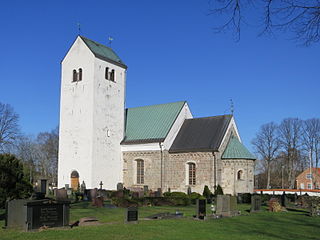
Vä Church, sometimes also called Saint Mary's Church in Vä is a well-preserved Romanesque church in Vä, in the southern Swedish province of Scania. It belongs to the Church of Sweden and is a listed building. It was built in the early 12th century, at a time when Scania was part of Denmark. The building was commissioned by a member of the Danish royal family, probably Queen Margaret Fredkulla. The church originally consisted of a nave, a chancel with an apse and two western towers. Quite soon after being finished, it was donated to Premonstratensian monks who used it as the church of their monastery until 1213. It simultaneously functioned as the parish church of Vä. At the end of the Middle Ages, a third tower was built, and in 1593 the building was enlarged. At the beginning of the 19th century, the western towers were demolished. A major restoration was carried out in the 1960s.

Erich Lassota von Steblau was a diplomat and military officer from Silesia. Born in an aristocratic family, he studied at the University of Padua before joining the War of the Portuguese Succession on the side of King Philip II of Spain. After the war, he became employed by Archduke Maximilian of Austria, and accompanied the archduke in his failed attempt to obtain the Polish throne. Lassota accompanied Maximilian in captivity, until he could return to his family estate in 1590. He was then sent on a mission to try to form an alliance with Russia against Maximilian's Swedish rivals but failed and was again taken prisoner. He remained in Swedish captivity for three years. Following this, he was again sent on a mission by Maximilian, this time successful, to the Zaporozhian Cossacks in present-day Ukraine, in order to convince the Cossacks to join the Imperial forces in its War against the Ottoman Empire. After his return, Lassota was promoted to Inspector General of Upper Hungary, a position he kept until the uprising of Stephen Bocskai in 1604, when his property was despoiled by the rebels. He continued to remain in Habsburg service, however, and in 1611, he was appointed to the Imperial Council. He died in 1616, in Košice.
